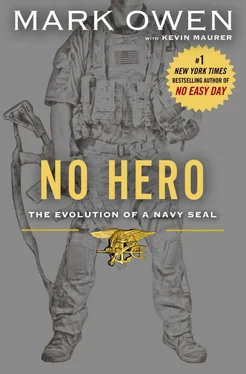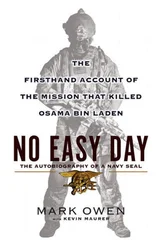After close to four hours of walking, we were not only cold but also tired. I could tell it was taking a toll on the Afghan commando unit that was with us. They weren’t being proactive and we had to order them to pull security. They weren’t focused on the mission. They wanted to go home.
Our snipers found the enemy’s trail and we slowly started the chase. After about a half hour of moving, the drone pilots once again reported in that the Taliban patrol had come to a building and stopped. Hopefully bedding down for the night.
At least one guard was positioned on a little saddle overlooking the valley.
The only approach to the new target was between the saddle and a small knoll. As we moved into position and began slowly making our way toward the target, the Taliban guard spotted us. I was near the front and watched the guard stand up and stare at us for a long second. I could see an AK-47 slung across his chest. He then turned and tore ass toward the house where his buddies were sleeping.
The radio traffic cracked in my ear.
“We have multiple movers,” the drone pilot said. “I say again, we have multiple movers.”
We were in the low point of the saddle. We needed to get to the high ground as quickly as possible. Sprinting up the snow-covered hill, I led my team to the end of a line of compounds opposite where the fighters were running. I was no longer cold. There was no doubt we were about to get into a fight.
The snipers, at the front of the formation, were already set up. As I got up to the knoll, I could hear their rifles firing. I saw two fighters in a dead sprint attempting to run down an adjacent knoll. Our snipers dropped them like rag dolls from more than one hundred and fifty yards away. The rest of the fighters stopped running and dove for cover.
I moved my team farther up the knoll looking for a way to flank the enemy. Our snipers were in place and had the enemy pinned down and unable to escape. The Rangers had now made their way to the top of the knoll and were stacked up on the back side of the hill behind the line of compounds.
I grabbed the Ranger captain.
“Hey,” I said. “Your guys want to have some fun?”
I took the captain up to the crest of the hill and told him to set up his machine guns and lay down a base of fire on the enemy position. The Rangers carried the heavier belt-fed machine guns and ammo, and I knew they would love to lighten their loads and get in some action.
The Rangers set up with their machine guns and grenade launchers. I shouldered my rifle and aimed my infrared targeting laser at the enemy location, marking them for the Ranger platoon.
“We’re going to flank right and I’ll hit you up on the radio when it’s time to lift your fire,” I said. “Until then, fuck ’em up.”
Before I even got off the knoll, I could hear the rattle of the machine guns and thump of grenades. Nobody likes carrying the big guns until you need them. It was an awesome sound as the Rangers laid down covering fire that would hopefully keep the enemy busy as my team flanked their position.
“We have squirters moving on your left,” the drone pilot said over the radio.
The snipers stayed in position and focused on the enemy to our front, while Steve’s team maneuvered to intercept the movers to our left. My team, with the combat dog, or “hair missile,” and the troop chief, continued to move around from the right to eliminate the small pocket of enemy still remaining in the house. We had a perfect “L”-shape ambush on the enemy position.
With the deep snow and uphill terrain, it took us a few minutes to move into position. We crept down toward the building. Our hope was that their attention was focused on the fire coming from the Rangers and our snipers and they wouldn’t notice us approaching from their left flank. Up ahead, I could see the Rangers’ tracer rounds racing across the small valley and smashing into some small shrubs and trees. Without night vision, it looked like lasers in a science fiction movie.
We pushed the “hair missile” out in front of us as we made our way down the small hill and closed in. It felt like we were about to walk directly into the Rangers’ tracers when my troop chief got on the radio and had them cease-fire.
Above me, I heard the familiar hum of the AC-130’s engines. We were “troops in contact,” which is a fancy way of saying “under fire.” All the aircraft that had previously said they couldn’t drop bombs were now trying to get in on the action.
It’s funny how that works.
Steve and his team were using the AC-130 to take out the squirters. I could hear Steve calling for fire. About a minute later, the roar of the plane’s guns echoed down the valley.
The quiet valley was no longer calm. It had become almost deafening with the sound of automatic weapons fire and close air support. Our position was now quiet. No one spoke. We all were focused ahead. I saw the dog zigzag its way forward, sniffing at the snow, looking for a scent. To my right, I could hear my troop chief on the radio coordinating with our troop commander.
So far, we hadn’t found any fighters. The snow was deep and it was hard to walk. I had my night vision goggles down and strained to see any movement. My eye never lingered for more than a second on anything. I scanned ahead of me before shifting my gaze closer to make sure I didn’t miss anything at my feet. This was the first time I actually felt comfortable on this mission.
Then, from my right I heard a burst of suppressed fire.
POP, POP, POP.
I spun around and caught the troop chief’s last few shots as he backpedaled away. In the snow at his feet, I could see what looked like a dead fighter. The troop chief was startled.
“Motherfucker,” the troop chief mumbled under his breath.
The troop chief wasn’t usually in the front with the assault teams. Since we had so many moving pieces, he was moving along with us. His job was more coordinating and talking on the radio, so when the fighter stirred directly in front of him, he was caught off guard.
From what I could tell, it looked like the fighter might have been wounded in the initial fight and simply hidden in his position and waited to ambush anybody that approached. He was lying so still the troop chief didn’t see him and almost stepped on him.
We continued clearing down the knoll, step-by-step, through the knee-deep snow. As we closed on a small group of buildings, I saw the body of another fighter. I slowly walked over, my rifle aimed at his back. Another SEAL teammate rolled him over, while I covered him. The fighter was dead, machine gun rounds having torn open his chest.
In a small cluster of bushes, we found another body. He was crumpled facedown in the snow, his AK-47 nearby. We found three more bodies nearby for a total of five fighters at our location. The initial barrage from our snipers and the covering fire from the Rangers had done the job.
Once Steve and his team were done calling in close air support from the AC-130, the silence was eerie. I could hear Steve on the radio. His team had killed two fighters. All around us, the Rangers set up security while we combed the bodies for intelligence. We searched through the fighters’ pockets, looking for anything that could lead us to another target.
All of the fighters were loaded down with chest racks full of magazines, grenades, and even medical kits. These weren’t your standard farmer-by-day, Taliban-fighter-by-night types. They had good equipment and looked like they had maintained it well. They were pipe-hitting, trained, and well- equipped fighters.
Once we were sure the target area was secure, we walked the two conventional Army battle space owners around and showed them each dead fighter and their weapons. This was one of the formalities required under the current rules of engagement. While they took pictures and notes, we gathered up the fighters’ weapons and gear and destroyed them with explosives.
Читать дальше










